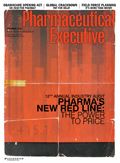Taking Stock: Notes on the Industry Audit
Our October issue highlights a latent threat to Big Pharma: the behavioral mindset that may be best characterized as "ageing in place."
AUTUMN IS THAT TIME WHEN THE BARE FRESHNESS OF YOUTH YIELDS TO THE WEATHERED FOLDS OF MATURITY. True to form, our October issue highlights a latent threat to Big Pharma: the behavioral mindset that may be best characterized as "ageing in place." It's what happens when businesses grow so large as to spawn their own internal weather patterns, one where markets and customers are treated as inhabitants of an entirely different solar system—unnoticed, neglected, and forgotten. Past successes founded on the blockbuster sales model have led to an orgy of size and scale, which leads to an equally big question: is this industry nimble enough for a new era where medicine is personal, science is targeted and the best new breakthroughs come in smaller packages?

William Looney
The cover feature this month is Professor Bill Trombetta's annual audit of companies that top the charts in delivering value to shareholders. It answers our question by showing that, when it comes to size, there is virtue in sitting in the middle. That's the spot where you are not too small to reap the growth surplus that comes from global reach, nor too large to be distracted by the logistics of responding to a new market model that requires abandoning past commitments, at warp speed. His 2011-2012 data on the 24 largest companies in the industry found that, of the top 10 in sales, only Johnson & Johnson, Abbott, and Roche were able to grow revenues; the others fell back into negative territory. It was the 16 smaller, more nimble "stealth" companies that posted the largest gains, led by Gilead, Celgene, and the three generic manufacturers on the list: Actavis, Mylan, and Teva.
The Audit notes that while the strategic success factors underlining shareholder value—a strong therapeutic focus and careful management of expenses—remain constant, what is emerging as paramount is pricing power. And that depends almost entirely on whether a company comes in first with a new indication—that coveted "blue ocean" space—or can offer a compelling, unique value proposition that payers will accept. In other words, today's market power principle is this: it's all in the pricing, stupid.
But this thesis faces a big test ahead, as witnessed by this year's Audit winner, Novo Nordisk. Its best in class positioning around the diabetes blockbuster Victoza fell victim last month to a decision by Express Scripts to drop the drug from its formulary list in favor of an older alternative. As Senior Editor Ben Comer writes in this month's accompanying feature, "Field Force Evolution: Adapting to Thrive in a New Market," how much longer can pricing power last in a US market where just one PBM controls 40 percent of all drugs dispensed?
Implicit in the Audit is the assumption that, despite some pockets of leading-edge dynamism, biopharma is becoming a classic mature industry, characterized by slower revenue growth, intense market competition, and eroding margins. Assuming this is true, other parts of our coverage detect numerous environmental trends that will accelerate the transition. One telling example is the costs of regulatory compliance. The Center for Medicare and Medicaid Services (CMS) claims that observing the provisions of the new Physician Payments Sunshine Act should cost a US drug maker no more than $200,000 a year in labor and infrastructure costs. However, we beg to disagree—one of this month's columns ("Big Pharma's Newest Cost Center") projects the true cost of compliance will be 10 to 30 times higher.
Likewise, in "Not Much Ado About the ACA," Pharm Exec Editorial Advisory Board (EAB) member Mason Tenaglia delivers a jaundiced assessment of the impact of the Affordable Care Act (ACA), contending that companies with the most innovative and promising therapies will, even in the best scenario, remain a hostage to regulatory uncertainty. He notes that volumes and margins for premium therapies hinge on regulatory precedents that have yet to be set. The most important involves the legal right to offer new enrollees in the ACA's state and federally-administered insurance exchanges access to the co-pay offset cards and coupon programs that help make these therapies more affordable to patients in private plans. More broadly, Tenaglia sees US health reform as reinforcing the value of strategic flexibility, of being able to anticipate, shift course, and adapt as the effects of this labyrinthine initiative to impose order on nearly a fifth of the US economy kicks in, in ways that no one currently can imagine.
The message is clear: if your response to all this is to "age in place," you won't even be on our Audit five years from now.

William Looney Editor-in-Chief wlooney@advanstar.com

Cell and Gene Therapy Check-in 2024
January 18th 2024Fran Gregory, VP of Emerging Therapies, Cardinal Health discusses her career, how both CAR-T therapies and personalization have been gaining momentum and what kind of progress we expect to see from them, some of the biggest hurdles facing their section of the industry, the importance of patient advocacy and so much more.
Applying Porter’s Five Forces to Portfolio Management in Pharmaceutical R&D: A Strategic Roadmap
March 17th 2025The increasing costs and complexity of R&D in the pharmaceutical industry have necessitated the adoption of strategic portfolio management to optimize resource allocation and enhance competitive advantage.